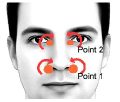Mirror-Magnified Moonlight —

A couple out in Arizona, Richard and Monica Chapin, have built a moonlight magnifier (or, as they call it, an "interstellar light collector"). Exposure to concentrated lunar rays, they claim, can have all kinds of positive medical benefits. They hope it may even heal cancer. It cost them over $2 million to build the thing. According to their website,
starlightuses.com, here's how the machine works:
The Interstellar Light Collector rotates a full 360 degrees, and can be aligned with the position of the moon to 1/10,000 of an inch in accuracy. With a collection surface of 3,000 square feet, the collected light can be focused into an area as large as 10 by ten feet or as small as 1mm that can pulsated or applied as a laser and transmitted directly into the accompanying research facility.
The
Arizona Republic recently
published an article about this device. They describe in a bit more detail exactly what happens during a therapeutic session:
Visitors receive "moonstones," or rocks purified by sunlight, before they enter the basking zone in twos and threes. They are instructed to soak them with lunar rays for a personally sanctifying energy.
The Chapins don't charge money for this, but they do encourage visitors to make $10 donations and are seeking investors.
I'm willing to accept that light therapy has positive benefits, but I'm skeptical that moonlight has healing powers any different or greater than those of sunlight. Why would it, since it's just reflected sunlight? The Chapins claim that moonlight can't burn us like sunlight (right, because it's a lot less bright) and that moonlight "presents a distinctive spectrum composed of more reds and yellows, and possesses a different frequency than sunlight. This specific light spectrum has never been artificially duplicated." They admit that the healing benefits of moonlight have never been scientifically tested, but they're gathering anecdotal evidence to build their case.
I actually think it would be kind of cool to experience this thing. Would it be possible to get a moon tan? But I wouldn't look on it as anything more than an entertaining novelty, and I wouldn't expect any medical benefits from it beyond those gained from light therapy in general.

 A couple out in Arizona, Richard and Monica Chapin, have built a moonlight magnifier (or, as they call it, an "interstellar light collector"). Exposure to concentrated lunar rays, they claim, can have all kinds of positive medical benefits. They hope it may even heal cancer. It cost them over $2 million to build the thing. According to their website, starlightuses.com, here's how the machine works:
A couple out in Arizona, Richard and Monica Chapin, have built a moonlight magnifier (or, as they call it, an "interstellar light collector"). Exposure to concentrated lunar rays, they claim, can have all kinds of positive medical benefits. They hope it may even heal cancer. It cost them over $2 million to build the thing. According to their website, starlightuses.com, here's how the machine works: 102-year-old Saleh Talib Saleh says he had had dreams when he was younger of growing horns from his head.
102-year-old Saleh Talib Saleh says he had had dreams when he was younger of growing horns from his head.  Following hot on the heels of the chocolate Virgin Mary (which, as many people pointed out, looked more like the Maltese Falcon) comes: Jesus as seen on an ultrasound picture.
Following hot on the heels of the chocolate Virgin Mary (which, as many people pointed out, looked more like the Maltese Falcon) comes: Jesus as seen on an ultrasound picture.  Want some marijuana? Of course, here in America it's illegal to buy the real thing, but you can buy mock marijuana... lifelike marijuana plants made out of silk and wood. It would be a pretty cool conversation piece to have sitting in the corner, especially if the police ever show up unexpectedly. The mock marijuana is sold by New Image Plants, operated by pro-pot activist Joseph White. It's a small business. Most of his customers, ironically, are law-enforcement agencies. But he did just sell $40,000 worth of his plants to the set director of Weeds, a Showtime series about a marijuana-dealing suburbanite soccer mom. White notes that he does have some customers who seem to think he's selling the real stuff, but he notes that: "We cannot be held liable for stupid people smoking our plants."
Want some marijuana? Of course, here in America it's illegal to buy the real thing, but you can buy mock marijuana... lifelike marijuana plants made out of silk and wood. It would be a pretty cool conversation piece to have sitting in the corner, especially if the police ever show up unexpectedly. The mock marijuana is sold by New Image Plants, operated by pro-pot activist Joseph White. It's a small business. Most of his customers, ironically, are law-enforcement agencies. But he did just sell $40,000 worth of his plants to the set director of Weeds, a Showtime series about a marijuana-dealing suburbanite soccer mom. White notes that he does have some customers who seem to think he's selling the real stuff, but he notes that: "We cannot be held liable for stupid people smoking our plants." Chinese women are reportedly flocking to buy Bolibao ('Stay Fit' in English), a pill that, according to its manufacturer, can transfer body fat from a woman's hips to her breasts. Therefore it supposedly slims your hips and boosts your bra size at the same time. It's being heavily marketed on Chinese TV despite the fact that a) it doesn't work, and b) it causes a variety of negative side effects. The brazenness of the scam is pretty remarkable. The Shanghai Daily reports:
Chinese women are reportedly flocking to buy Bolibao ('Stay Fit' in English), a pill that, according to its manufacturer, can transfer body fat from a woman's hips to her breasts. Therefore it supposedly slims your hips and boosts your bra size at the same time. It's being heavily marketed on Chinese TV despite the fact that a) it doesn't work, and b) it causes a variety of negative side effects. The brazenness of the scam is pretty remarkable. The Shanghai Daily reports:  The following technique to relieve nasal congestion by massaging points on your nose has been widely linked to (especially after getting posted on digg.com). Supposedly this technique will provide immediate relief from congestion. Here's what you're supposed to do:
The following technique to relieve nasal congestion by massaging points on your nose has been widely linked to (especially after getting posted on digg.com). Supposedly this technique will provide immediate relief from congestion. Here's what you're supposed to do:  The makers of MagneurolS·6 promise that this little pill has some remarkable properties. It will give you "the ability to plug into Earths complex magnetic fields" thereby enhancing your extra-sensory perception and psychic abilities. Of course, never mind that its ingredients are nothing that you can't find in any vitamin supplement costing far less than $49 a bottle. You won't care about such trivial matters once your sixth sense (S·6) has been awakened. One potential danger, however. When taking Magneurol, some users report that "they can 'feel' the radiation, or something like it, emanating from the [cell]phone where they could not do so before." Of course, with the psychic powers the pill bestows, you shouldn't need a cellphone. So that radiation won't be a problem.
The makers of MagneurolS·6 promise that this little pill has some remarkable properties. It will give you "the ability to plug into Earths complex magnetic fields" thereby enhancing your extra-sensory perception and psychic abilities. Of course, never mind that its ingredients are nothing that you can't find in any vitamin supplement costing far less than $49 a bottle. You won't care about such trivial matters once your sixth sense (S·6) has been awakened. One potential danger, however. When taking Magneurol, some users report that "they can 'feel' the radiation, or something like it, emanating from the [cell]phone where they could not do so before." Of course, with the psychic powers the pill bestows, you shouldn't need a cellphone. So that radiation won't be a problem.